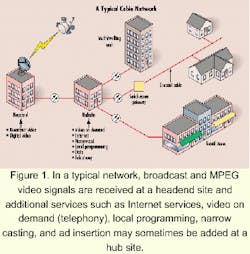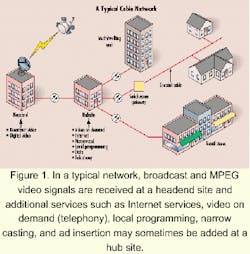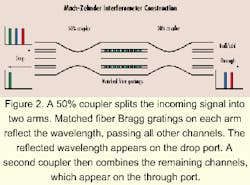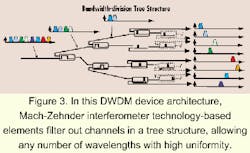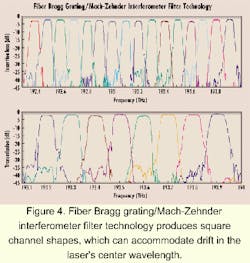DWDM a feasible alternative for band width-hungry broadband networks
Eric Campbell
ADC Fiber Optics Div.
With the explosion in demand for new digital services, cable operators are adding expanded channel lineups and interactive offerings such as video on demand, email, digital music, and Internet access at a record pace. In systems of all sizes, the penetration rate for digital services typically exceeds 10%, with some markets approaching 20% during the first year. But success with digital deployment often creates a massive problem-bandwidth management on networks already running at or near capacity.
When operators add services and subscribers to the network without increasing capacity, bottlenecks can occur, especially at the access portion of the network near subscriber premises. With less bandwidth available to each household, Internet connections and video downloads can become sluggish, television picture quality suffers, and service activation and authorization are delayed. In today's ultra-competitive environment, discriminating customers will quickly seek services from other network providers.For network operators, however, creating extra bandwidth is expensive and time-consuming, particularly if it means constructing miles of new fiber. A conventional approach to accommodate increased demand has been to build fiber-based network overlays in the plant and to add Internet-protocol (IP) routers, quadrature amplitude modulation (QAM) devices, DOCSIS (data-over-cable service interface specification) cable modems, and other expensive equipment to the headend. With this solution, a large amount of headend rack space is needed to house this additional equipment, sometimes requiring the construction of new facilities (see Figure 1).
The addition of more services and subscribers to the network does not have to result in lower available bandwidth per subscriber. An alternative approach involves dense wavelength-division multiplexing (DWDM), a high-capacity optical-transport technology where multiple services or information streams can be added to the existing fiber network using different wavelengths. Network overlays are not required, preserving valuable dark-fiber capacity for future expansion.
DWDM transport is protocol- and bit-rate-independent. Therefore, a DWDM wavelength doesn't care what service it is carrying or at what speed. With this technology, different services are multiplexed together on a single fiber.Most DWDM multiplexer and demultiplexer components are passive devices (i.e., passively temperature compensated), so additional control elements and power components are not required. That allows cable operators to remove a lot of the electronic equipment in a distribution hub and replace it with passive optical devices, which offer high reliability under typical operating conditions. With passive devices located at remote hubs, a lot of expensive, sensitive, hub electronic equipment can be eliminated or relocated to centralized sites. This network design also makes maintenance more accessible and reduces the requirement for costly truck rolls.
In typical cable environments, return-path noise can become a significant issue with the addition of more two-way services. Internet services involving video applications, for example, require more upstream bandwidth and lower noise to be effective. In this scenario, the DWDM technology can relieve bottlenecks with add/drop devices at hub locations in the field. It also provides high dynamic range; large fluctuations in the return-path signal are tolerated with little or no effect on system operation.
In a DWDM system, modular laser transmitters-operating at International Telecommunication Union (ITU) grid wavelengths-at the headend can be quickly added to increase the information capacity and best utilize fiber's large bandwidth potential as subscribers or services are added to the network. Modular laser transmitters can be used to add 4, 8, 16, 32, or more independent wavelength channels with 200-GHz or 100-GHz channel spacing.
Soon, tunable lasers will reach the market. These lasers can "tune" to different wavelengths, in much the same manner as cable frequency-agile modulators tune to various channel frequencies.The construction of DWDM passive devices allows a great deal of design flexibility. Not only can a device incorporate any number of channels, but also performance characteristics such as insertion loss, channel spacing, and crosstalk are tailored to the system.
Modular system construction is another advantage. Channels, or groups of channels, can be added to the DWDM device in stages, allowing cable network operators to increase bandwidth as needed. This capability minimizes initial costs and defers equipment purchases until required by service conditions or network expansion.
DWDM device vendors use different multiplexer and demultiplexer component technologies to combine the various ITU grid wavelengths to a single fiber. Each technology has advantages and disadvantages relative to operational temperature stability, performance, cost, and potential for high-volume manufacture. The most widely deployed DWDM filter technology uses thin-film filters (TFF) for 200-GHz-, 100-GHz-, and potentially 50-GHz-spaced channels.
Among the most promising of the newer technologies are the implementations of fiber Bragg gratings (FBGs) such as FBG/MZI (Mach-Zehnder interferometer). The idea of placing FBGs inside MZIs to make a wavelength-selective filter was first proposed by researchers at the Canadian Communications Research Center in the 1980s. Since then, the basic device has been the focus of research in a number of organizations worldwide in both fiber and planar form. Many of these devices are now readily available on a commercial basis. Other FBG implementations use a combination of circulators and fiber gratings for DWDM applications but at the expense of higher insertion loss and cost.
DWDM devices must have high reliability to guarantee network availability. MZIs are fabricated using a mature fused-biconic-taper (FBT) coupler. By combining this technology with proven FBG, multiplexer and demultiplexer filters are constructed so that the signal always remains in the fiber. That eliminates optical alignment and pigtailing problems and leads to a stable, low-loss device. The FBG/MZI devices are constructed with optical couplers proven to have exceptionally high reliability with over 10 million device hours of lab testing.Gratings are written into the core of the fiber using standard FBG fabrication processes. Each grating design provides a high degree of control of the filter characteristics, offering very high stability for the product's lifetime. The resulting device has good wavelength stability-on the order of 1 pm/°C-over an operating temperature range of -5°C to +65°C. The FBG and TFF-based devices exhibit low insertion loss, and since the optical path length through the devices is very short, polarization effects are minimal.
The all-fiber construction of FBG/MZI devices enables high-volume, low-cost production. The FBT technology can be mass-produced using modified coupler manufacturing techniques.
In FBG/MZI devices, a 50% coupler equally splits the incoming signal into two arms of the device (see Figure 2). Identical FBGs on each arm reflect one, or several, of the wavelength channels while passing all other channels. A second coupler then combines the remaining channels. Due to the phase relationship between the two signals, this configuration allows the reflected wavelength channel to appear on a separate "drop" port, while all of the remaining transmitted channels appear on the "through" port. The insertion loss of a basic grating MZI component is typically 0.5 dB to either the "drop" or "through" ports.
The basic MZI technology is used in filter elements for a DWDM device architecture based upon recursive bandwidth division in a tree structure (see Figure 3). By combining elements that filter out individual or groups of channels in a tree structure, a DWDM device with any number of wavelength channels can be constructed with high uniformity. Apart from being low loss, a significant advantage of this technology is that very narrow channel widths and spacing can be achieved while maintaining a high level of isolation between wavelengths. A further advantage is that each device is added independently, allowing network operators to construct modular systems and increase the number of channels as needed.
Finally, with FBG/MZI filter technology, the channel shape is conducive to using lower-cost ITU lasers at the headend. This technology produces square channel shapes that exhibit flat tops and steep sides, as shown in Figure 4. The square channel shape can accommodate drift in the laser's center wavelength-an advantage over other DWDM technologies, which have domed channel shapes.
DWDM components offer a cost-effective alternative for service and customer additions to a cable network. With passive devices located at remote hubs, electronic equipment is confined to centralized sites where maintenance is more accessible. Service upgrades and bandwidth is controlled in a scalable and cost-effective manner. DWDM components have proven reliable for high-speed, multiprotocol environments, allowing network operators to keep up with the increasing demand for higher bandwidth.
Eric Campbell is program marketing manager, photonic components, for ADC Fiber Optics Div. (Minnetonka, MN).
